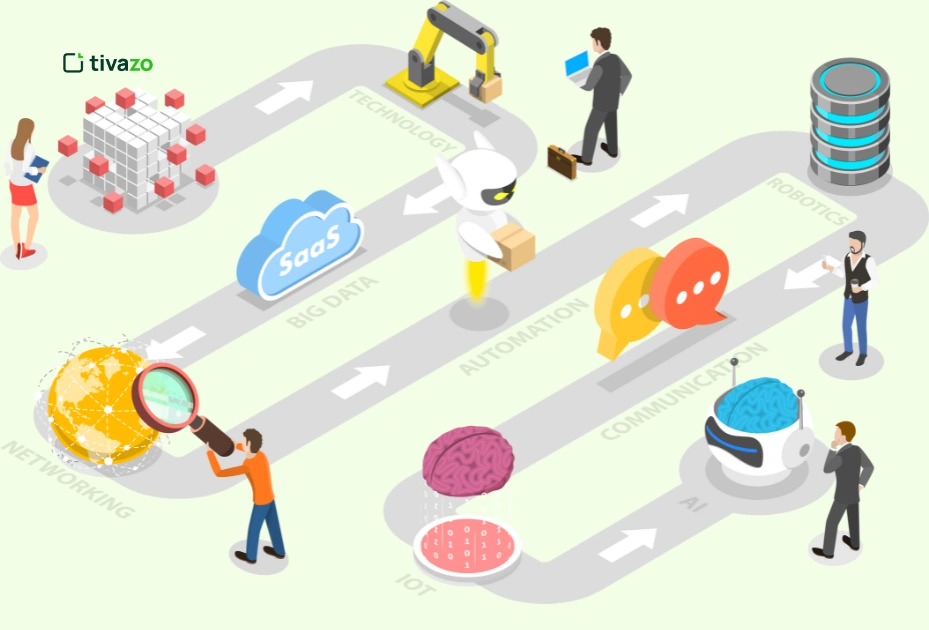In today’s rapidly evolving business ecosystem, business transformation is no longer optional; it is a necessity for survival. Businesses today are constantly disrupted by new technologies, changing customer expectations, and ruthless competition. The decisive factor between business success or business failure often hinges on an organization’s ability to adapt, innovate, and change their operations in accordance with market changes.
However, business transformation cannot be as narrow as making a digital transformation or simply re-structuring the organization. Business transformation affects every aspect of a business: business culture, business processes, business technologies, and ultimately, business mindsets. Progressive businesses will begin to realize that business transformation is not a single project, it is a journey.
To support businesses through this journey, we need to utilize proven strategies that help focus on clarity, agility, and collaboration to navigate the challenges of business transformation. Although this is not the focus of this piece, platforms like Tivazo help to facilitate this journey and allow teams to come together, stay aligned and track their progress, without excess effort.
In this article, we will explore 7 effective and practical strategies for business transformation that will help you implement smarter, more sustainable growth!
Key Takeaways:
- Understanding Business Transformation: A Strategic Necessity
- The Link Between Organizational Change and Transformation
- Key Strategies for Successful Business Transformation
- Bonus Strategy: Customer-Centric Transformation
- Common Pitfalls in Business Transformation and How to Avoid Them
- How Digital Innovation Fuels Business Transformation
- Conclusion: Smart Transformation Starts with Smart Tools and Clear Goals
- FAQs
Understanding Business Transformation: A Strategic Necessity

Before we get into the strategies, we should clarify the meaning of business transformation. At its most basic level, business transformation is simply ripping apart what a company does and rethinking how to do it to create performance improvement and value that’s sustainable.
There are several options for business transformation:
- Operational Transformation — redesigning workflows, streamlining supply chain partners, or automating tasks that are repetitive.
- Technological Transformation — integrating new digital tools, adopting the cloud, or bringing in AI-assisted solutions.
- Cultural Transformation — changing mindset, values, and behaviors that help organizations to consider change and innovation.
- Organizational Transformation — restructuring teams, redefining functions, or changing leaders.
Each type of business transformation requires planning and vision. When the organization rallies around the planning and vision, business transformation can deliver agility, improved customer experiences, and competitive advantage.
The Link Between Organizational Change and Transformation
Organizational change is often seen only as part of the bigger picture of business transformation. It is an important piece of the puzzle — the human and cultural aspects of change. It’s how people adapt to new ways of working, how leaders act—and inspire others to act—around new initiatives, and how processes change and evolve internally.
Effective management of organizational change is essential to a company’s transformation. If employees don’t buy-in, and there is no alignment to support cultural shifts, even the most well-intentioned and designed transformation strategy can stall.
A few points worth highlighting related to organizational change as part of transformation:
- It requires communication and transparency.
- Employees should feel included and empowered, not sidelined or excluded.
- Initiatives around change need to consider and address resistance to change at the outset.
When we understand the link between organizational change and transformational success, we can craft holistic transformation programs that consider both technology implementation and support transformation of employees.
Key Strategies for Successful Business Transformation

In this article we identify seven key strategies that organizations can use to help them manage their business transformation process as smoothly as possible, with examples of how a modern platform like Tivazo unintentionally can support the various stages of the process.
Strategy #1: Align Leadership Around a Clear Vision
Transformational business transformation processes start at the top. Leaders must come together around a unified vision that describes the reason for the change and what constitutes success. When leaders do not present a unified vision to their teams, opinions can differ, which impedes progress.
- Why it’s important: A clear vision ensures that each team is headed in the same direction.
- How to do it: Develop a short mission statement that reflects the goals of the business transformation and continue to promote that statement as the journey unfolds and cross-departmental communication remains ongoing.
- Tooling with a modern edge: Modern collaboration tools like Tivazo allow leaders to broadcast their goals openly and track alignment to support that vision in real-time.
Strategy #2: Identify Custom Goals with Measurable Milestones
Transforming a business is a daunting undertaking. Breaking the business transformation process down into custom goals with measurable milestones makes the journey manageable and inspires motivation.
- Build SMART goals: Specific, Measurable, Achievable, Relevant and Timely thinking is essential.
- Benefits: Create measurable markers that align an organization, allowing for ongoing progress monitoring that holds people accountable.
- Tooling with a modern edge: Modern platforms like Tivazo offer dashboards that show the entire team’s progress toward goals, which keeps teams focused while demonstrating that there is work being completed toward goals.
Strategy #3: Adopt Digital Technology for the Right Reasons
Digital technology is such a strong ally in driving business transformation that it’s easy to lose sight of the core purpose that each technology might serve. Instead of adopting new technology for the sake of having technology, it’s crucial to align it with the goals of the business.
- Examples of innovation: AI-driven analytics; workflow automation; cloud-based collaboration platforms.
- Solution: Adopt technology for the purpose of adopting it without aligning to goals.
- Pro tip: Take advantage of integrated technologies, like Tivazo, so that companies can adopt new technology all at once, vs. piecemeal. Doing the latter can result in inconsistencies and fragmentation.
Strategy #4: Break Down Communication Barriers

One of the biggest threats to the success of a transformation project is weak communication and siloed departments.
- Problem: The misalignment of teams, duplication of efforts, and delays in decision making.
- Solution: Increase transparency via a consolidated information flow as well as live project work in progress.
- Indirect plug: Tivazo provides a central task management platform that makes it easy to break down departmental/yearly silos.
Strategy #5: Up-skill Employees with Training and Ownership
Focus of transformation is not just about process/change tools, it is about the people involved.
- Why: Employees that are engaged drive innovation and adapt to change faster.
- How – Employee: See menu of continuous learning options for all employees; include future employees in the change decision-making process; recognize employee involvement in change.
- Support: With the ability to track progress, managers can monitor employees’ learning & development without micromanagement when using Tivazo.
Strategy #6: Make Data the Center of Every Decision
Making decisions based on data means speed, accuracy, and confidence.
- Analytics: Analyze KPIs, customer patterns, internal efficiencies, and conduct assessments that have the flexibility to quickly modify and reflect strategy.
- Integrated Insights: Centralized platforms like Tivazo help integrate data across different departments, and provide greater accessibility to actionable insights.
- Use Less Guesswork: Create better resource allocation, and profit from your marketing dollars/investments.
Strategy #7: Instead of Transformation – Think Scalable

Continual transformation is an ongoing trajectory and journey – not a one-time event.
- Scalability: Change things to create process flows and systems that scale with your growth.
- Why: This minimizes repeating processes, and reduces transformation fatigue from hitting refresh on everything.
- Scalable platforms: Things like Tivazo are scalable to make sure that your tools scale with your ever-evolving requirements.
Bonus Strategy: Customer-Centric Transformation
A successful transformation of a business also includes the transformation of the customer experience.
- Personalization: Products and services to individuals.
- Omnichannel support: A response that is aligned across all platforms.
- Internal Alignment: Capture the insights from customers and align this with teams internally to provide quicker and smarter responses.
- Role of tools: While the use of tools is often invisibly integrated, solutions like Tivazo help organizations align customer data with teams and workflow in the background.
Common Pitfalls in Business Transformation and How to Avoid Them
Organizational business transformation journeys can encounter many challenges at a previous organization.
A number of typical challenges are:
- Resistance to change: Offer appropriate transparent communications and involve team members early.
- Leadership commitment: A commitment to champion and model change cannot simply by assigned to people.
- Too many tools: Select simple, integrated tools and technology to eliminate complexity.
- Lack of commitment: Make regular reviews and adapt plans.
Avoiding the challenges above is likely to increase the odds of smooth business transformation and long-term success.
How Digital Innovation Fuels Business Transformation

The issues around Digital Innovation fuelling Business Transformation are important for businesses who aspire to be forward looking or sustainable.
- Innovation is not about technology, its about embedding technology into the business model and cultures.
- Digital tools can offer real-time insights, speed, and agility as well as collaboration advantages.
- Strategic innovation contributes even further, from staffing to process to operational performance to customer engagement.
When innovation is thoughtfully implemented, it becomes the backbone of continuous transformation.
Conclusion: Smart Transformation Starts with Smart Tools and Clear Goals
For organizations today, business transformation is not an option—it is an obligation, no differently than preparing for a competitive landscape that will change over time. By working with leaders, organizations can foster buy-in and establish measurable outcomes that align the organization to know whether business transformation occurred. When this is done, organizations can foster purposeful digital innovation, remove silos of communication, empower employees, value data-driven decision-making, and consider scalability. By focusing on these elements, organizations can become more adaptable and capable of achieving long-term success.
It is not easy, but it is doable if there is a willingness to embrace the challenge and the support of leaders and change agents throughout the organization. This exploration was about strategy — the right platforms, like Tivazo, remain in the background to collaboratively empower the team, stay focused and aligned, track measurable progress, and mobilize rapidly.
It is time to react — start taking proactive steps to successful business transformation today, and watch an organization achieve results not typified by other organizations in an ever-changing environment.
FAQs:
What does business transformation mean?
Business transformation involves making transformational changes to a business’ operations. These changes include an overhaul of operations, culture, leadership, and technology to meet evolving market demands, increase efficiency and enable sustainable growth.
What are the 4 pillars of business transformation?
Most business transformations are built upon four key pillars:
- People: Building talent and development opportunities at all levels.
- Process: Improving operations and efficiency.
- Technology: Adopting cloud, AI and on-demand apps like Tivazo.
- Culture: The courage to ask for and promote adaptability, innovation and collaboration.
What is an organizational change?
Organizational Change is any change that impacts a business’ structure, strategy, or operations based on a need to respond to both internal and external pressures. A business transformation can be part of a business’ plan for organizational change designed to improve effectiveness and competitiveness.
What are the 4 types of organizational change?
There are four common types of organizational change:
- Strategic Change: Changing the organizations’ direction or goals.
- Structural Change: Changing an organization’s hierarchy or team structure.
- Process Change: Improving or changing a workflow.
- People Change: Changing team behavior, role clarity or team culture.
What is meant by digital innovation?
Digital innovation is defined as the use of digital technology to enable, improve or create new business processes, products or services. Digital innovation was a crucial component to enabling business transformation as it enables improved efficiency, enhances customer experience, and creates competitive advantage.
What is an example of digital innovation?
One excellent example is applying artificial intelligence-powered analytic capabilities to provide customer personalization or using a workflow software, such as Tivazo, to automate mundane processes. These advances improve operational efficiency and ultimately enhance decision making.
What are the stages of business transformation?
Typical business transformation phases include:
- Assessment – Understand where you are at and opportunities for change.
- Vision Setting – What are your goals? What do you want to become?
- Strategy Development – What is the roadmap and what will you need?
- Implementation – Follow the roadmap and roll out the transformation initiatives.
- Review and Optimize – Evaluate your measures of success, adjust strategies to enhance outcomes and Incremental improvements for sustainability.
What are the four R's of business transformation?
The four R's are typically referred to as the generic "Four R's” :
- Reimagine - What could the future state look like?
- Restructure - What are the business models and structures you will change?
- Reengineer - What core processes will you redesign?
- Revitalize - How will you invigorate people and refresh your culture or company for the better?
What is the role of digital transformation in business innovation?
Digital Transformation is the engine of business innovation, enabling companies to unlock new value creation opportunities, time-to-market improvement and customer journey improvement. Digitally transformed companies respond to change and lead the change in their industries.
What is digital innovation and transformation?
While digital innovation and digital transformation are often used interchangeably, the combined terms digital innovation and digital transformation allude to applying new digital tools and ways of thinking to all aspects of a business to develop flexible and smarter organizations that will achieve growth, operational efficiency, and competitive advantage.




